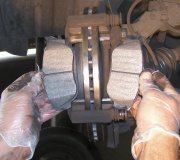Okay, sure. Removal/Installation procedures for rear brake calipers are as follows:
REMOVAL:
Raise and safely support the vehicle.
Remove the wheel and tire assembly.
If the caliper is to be removed from the vehicle, remove the bolt attaching the brake hose to the caliper. Discard the gaskets. Plug the openings in the caliper and brake hose to prevent fluid loss.
If the caliper is to be removed from the vehicle, lift up on the end of the parking brake cable spring to free the end of the cable from the parking brake lever.
Remove the bolt and washer attaching the cable support bracket to the caliper.
Remove the sleeve bolt, pivot the caliper up to clear the rotor and then slide it inboard off the pin sleeve.
If the caliper is being removed only for brake pad replacement or to provide access to the mounting bracket, rotor or other components, suspend the caliper with wire from the strut.
WARNING: Do not let the caliper hang from the brake hose. The hose may become damaged, causing possible brake failure.
INSTALLATION:
Inspect the pin boot, bolt boot and sleeve boot for cuts, tears or deterioration and replace as necessary.
Inspect the bolt sleeve and pin sleeve for corrosion or damage. Pull the boots to gain access to the sleeves for inspection or replacement. Replace corroded or damaged sleeves; do not try to polish away corrosion.
If not replaced, remove the pin boot from the caliper and install the small end over the pin sleeve (installed on caliper support) until the boot seats in the pin groove. This prevents cutting the pin boot when sliding the caliper onto the pin sleeve.
Hold the caliper in the position it was removed and start it over the end of the pin sleeve. As the caliper approaches the pin boot, work the large end of the pin boot in the caliper groove, then push the caliper fully onto the pin.
Pivot the caliper down, being careful not to damage the piston boot on the inboard disc brake pad. Compress the sleeve boot by hand as the caliper moves into position to prevent boot damage.
After the caliper is in position, recheck the position of the pad clips. If necessary, use a small prybar to reseat or center the pad clips on the bracket abutments.
Install the sleeve bolt and tighten to 20 ft. Lbs. (27 Nm).
Install the cable support bracket (with cable attached) with the bolt and washer and tighten to 32 ft. Lbs. (43 Nm).
Lift up on the end of the cable spring clip and work the end of the parking brake cable into the notch in the lever.
Position the brake hose on the disc brake caliper. Connect the hose to the caliper using the attaching bolt and 2 new gaskets. Tighten the bolt to 32 ft. Lbs. (44 Nm).
Bleed the brake system.
Install the wheel and tire assembly and locovered in this guider the vehicle. Check the parking brake adjustment.
Thanks for choosing 2CarPros. Com!
Wednesday, January 28th, 2009 AT 12:13 PM





